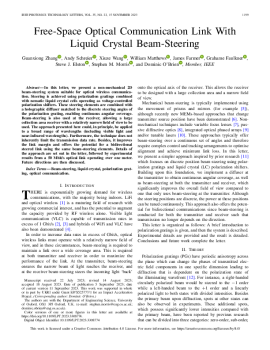Free-Space Optical Communication Link With Liquid Crystal Beam-Steering
Paper
My Thirteenth Paper
This work presents a novel, non-mechanical beam-steering system for optical wireless communication, demonstrating enhanced link margin and field of view with potential applications across various wavelengths.
Abstract
In this letter, we present a non-mechanical 2D beam-steering system suitable for optical wireless communication. Steering is achieved using polarization gratings combined with nematic liquid crystal cells operating as voltage-controlled polarization shifters. These steering elements are combined with a holographic diffuser matched to the discrete steering angles of the polarization grating, enabling continuous angular coverage. Beam-steering is also used at the receiver, allowing a large collection area receiver with a relatively narrow field of view to be used. The approach presented here could, in principle, be applied to a broad range of wavelengths (including visible light and near-infrared wavelengths). Furthermore, the technique does not inherently limit the transmission data rate. Besides, it improves the link margin and offers the potential for a bidirectional steered link using the same beam-steering elements. Details of the approach are set out in the letter, followed by experimental results from a 50 Mbit/s optical link operating over one meter. Future directions are then discussed.
Key Findings
In a recent study, a non-mechanical, voltage-controlled beam-steering system for optical wireless communication was developed and tested. This innovative system utilizes polarization gratings in conjunction with nematic liquid crystal cells, which function as voltage-controlled polarization shifters, to achieve beam-steering. The integration of these elements with a holographic diffuser, which is matched to the discrete steering angles of the polarization grating, enables continuous angular coverage. Notably, the beam-steering capability is extended to the receiver end, allowing the use of a large collection area receiver with a relatively narrow field of view. This approach is highlighted for its potential applicability across a broad spectrum of wavelengths, including visible light and near-infrared wavelengths. Furthermore, it is emphasized that the technique does not inherently limit the transmission data rate and can significantly enhance the link margin. The potential for establishing a bidirectional steered link using the same beam-steering elements is also discussed.
The experimental phase of the study involved the construction of a 50 Mbit/s optical link, which operated successfully over a distance of one meter. This experimental setup demonstrated the practical viability of the beam-steering system. It was observed that the system not only improved the link margin but also did not restrict the transmission data rate. The application of the beam-steering technique at both the transmitter and receiver was shown to substantially increase the field of view and the link margin, compared to using transmitter beam-steering alone. These results indicate that the proposed beam-steering system can be effectively utilized in a variety of applications, offering enhancements in link performance with the potential for integration into compact, low-cost components. Future work is anticipated to focus on extending the range of the system and advancing towards a bidirectional steered link.
